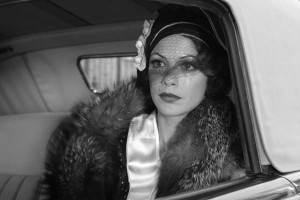
Mark Bridges’ amazing career as a costume designer has taken him, most recently, from the late 1920s to the early 1930s in The Artist to 1980s Boston in The Fighter to the turn of the century in There Will Be Blood to the disco era of Boogie Nights and Blow. I asked him if The Artist, being in black and white, posed any interesting challenges to his costume designing routine for a film. After initial camera tests it became evident that clothing with more texture read best on camera; beads, satin, lame, sequins, brocades and the like. Therefore it became more about the values of a fabric than the colors, he said. “And I also learned quite quickly that something could seem very colorful in a pattern or in a print, but translated to black and white, it could all become just mush because the values were the same, so they just all became the same grey. It was really interesting. So there’s not a lot of pattern in the film – if there is any of it, it’s pretty high contrast.”
This time period was also when hats were a staple of every outfit for men and women both. “I tried to use real hats whenever possible and then had them refurbished or steamed and cleaned,” said Bridges. He referenced the scene in the film where Peppy Miller, now an established star in her own right, gazes sadly from her limousine at George Valentin, who is down on his luck. It’s an arresting moment that will stay with you long after you see the film. Actress Bérénice Bejo wears a gorgeous cloche with an antique veil that Bridges found. “That was a really strong moment to me in the story and I wanted something really strong for that because it’s also shows time passing and you see that Peppy’s become a definite star by then. A lot of the film is a series of these moments – how are these things going to play. And that was just one of those things that I felt from the outset could be very beautiful as well as touching.”
Did the actors have any sort of input as to their costumes? “They were blank slates. They were there for me. They had obviously worked on their characterizations. They had talked to [director] Michel Hazanavicius, but they were very open to whatever I brought to them.” Jean Dujardin would try on a suit and he and Mark both would decide whether it was or wasn’t something the character George Valentin would actually wear and feel comfortable in. The Artist’s process, in fact, was very collaborative, including the entire team. “It really was a labor of love because we didn’t have all the money in the world and we didn’t have all the time in the world, but I think that everyone who was involved was there because they loved it, because they saw something in the script that they could latch into and feel they could contribute and be very creative with. We all worked together back and forth. I worked very closely with Julie Hewett [makeup] and Cydney Cornell our hair designer, and I think it shows. The right hand finally knew what the left was doing, which isn’t always the case.”
Bridges has worked on a diverse collection of films, including 8 Mile, Magnolia, and Fur: The Diane Arbus Story. I asked him what was the most important aspect of choosing a new project; did he ever base the decision on the time period the film took place in? “I love transitional periods. I feel like this was a transitional period – 1927 to 1932 – with very dramatic changes. Boogie Nights was too – from the end of the ’70s to the early ’80s. I love figuring out what each year looked like so you can follow the story better.”
Recent projects Bridges has contributed to include Paul Thomas Anderson’s The Master, set in the very transitional era of the 1950s with Phillip Seymour Hoffman, Joaquin Phoenix and Amy Adams; David O. Russell’s The Silver Linings Playbook starring Bradley Cooper, Jennifer Lawrence and Robert DeNiro, and Paul Greengrass’ film about Somali pirates, starring Tom Hanks – Captain Phillips.





